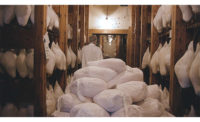By Sam Gazdziak, editor
The old saying, “What doesn't kill you makes you stronger,” has a great deal of truth to it, especially as far as 2009 was concerned. For some companies, it was a great year – pretty close to business as usual, with a couple of small hiccups along the way. For others, it was a challenge, as sales evaporated and markets dried up. However, those companies that made it through did so by adjusting their strategies and becoming better businesses, and the lessons learned in 2008 and 2009 will pay big dividends in 2010 and beyond.“[The year] 2009 was interesting, with the fact that there was a lot of unknown coming into the beginning of the year,” says John Stowell, director, fresh meats and sustainable programs for Dole and Bailey Inc. Stowell says that the Woburn, Mass.-based company started noticing the economic slide in late 2008, and it carried over into last year. In response, the company's management looked at the business and decided to look at new opportunities.
“It was good, because you can get stale if you're not constantly trying to look for new horizons,” he reasons. Dole and Bailey began a custom cutting program for some regional broadline distributors, which it had never done before. The company also made inroads into upscale retail markets, where it can produce specialized products.
“Now, we have more types of revenue streams,” Stowell says. “If one of them is not doing well, hopefully another one can make up the difference. It's made us a more diversified company and more successful.”
A similar sentiment was expressed by Dennis Stiffler, CEO of Mountain States Rosen (MSR). He notes that at the end of 2008, the company had just completed its transition from a joint-venture relationship to a wholly owned subsidiary of its producer group of Mountain States Lamb Cooperative and Formula-1 Veal. Soon after, the economic climate, housing market and unemployment rates caused consumers to become more cost-conscious, affecting the company's lamb and veal sales.
Stiffler called the year difficult but encouraging, as the company actually exceeded 2008's sales last year by aggressively pursuing new markets.
“MSR was very fortunate and able to counteract the price and margin pressures by growing our retail customer base as more consumers opted to eat at home,” he says. “We deepened relationships and grew existing retail businesses by capitalizing on our case-ready expertise and technologies.” Stiffler adds that the sales team had to drive growth in the lamb and veal category by promoting the Bronx, N.Y.-based company's capabilities and the benefits of lamb and veal case-ready products. The consumers that purchase those items, Stiffler says, are the types of higher-end customers that retailers want to attract, and by providing a good variety of products, those consumers will help increase a store's sales and reduce shrink.
On to 2010
Given the unwarranted fears of “swine flu,” the pork industry had a rougher year than other protein sectors. Gary Malenke, president of both Sioux City, Iowa-based Sioux-Preme Packing Co. and the North American Meat Processors Association, says that there was a fallout in demand for several months after the initial H1N1 outbreak. Demand did come back later on in the year, he adds. However, the pork industry struggled, and several politicians and industry leaders called for a bailout of the pork producers, who are still losing money for every hod sold.“In 2010, we are expecting higher prices in general for live hogs and for the associated cuts,” Malenke says. “The hard part is, what's that going to do to demand?” He also states that the pork herd, though it has shrunk lately, needs to get down to the right size in order to get the sector back to profitability.
Should a recurrence of the H1N1 flu strike, Malenke says that the industry is much more prepared to deal with any unfounded fears about eating pork products.
“The National Pork Producers Council and the [other] pork groups did an outstanding job of educating the retailers, consumers and the media to better understand what swine flu/H1N1 is,” he says. “Even if we have an outbreak again, I don't believe it would have any adverse material affect on pork.”
The first 2010 challenge for the pork sector came early, when Russia announced it was delisting all but a handful of pork plants because of trace amounts of an antibiotic found in several shipments. The country subsequently banned all chicken imports due to the U.S. practice of using a chlorine rinse on carcasses.
“It's strictly my opinion, but I think it's a political issue at work,” Malenke says. “Unfortunately, there are a number of times when you have delistments from a country that tends to have as much political issues behind it as there is factual issues.” In spite of the struggles with exports to Russia – Sioux-Preme's plant was one of the ones delisted by Russia – he believes that pork exports will be good in 2010.
“Whether it's the pork we're producing today or the poultry, someone is going to eat it,” he says.
On the domestic side, processors are expecting the food safety standards set forth by the USDA and FSIS to become increasingly stringent. However, that may not necessarily be a bad thing.
Stowell notes that Dole and Bailey has instituted pathogen intervention programs for its grinding and new marinating line to stay ahead of the regulations.
“We view that as a good thing,” Stowell says, “because it's an entry barrier for some people to get into the further processing end of the business. We feel if we can do it, and do it well, and put the pathogen interventions in place that meet the criteria, and if most people can't get in, that opportunity is much greater.”
Stiffler notes the importance of a USDA under secretary of food safety to help set the food safety agenda for the industry. Dr. Elisabeth Hagen, USDA's chief medical officer, was nominated to fill that position in late January. He also argues that the issues with foodborne illnesses and recalls have left the U.S. legislative bodies to try and legislate food safety, rather than let the processors control the issue.
“Government agencies and the private sector need to continue to work together to develop improved process control systems to manage and regulate food safety concerns, finding a balance between internal and external regulations that can together elevate the entire industry."
Tips for the independents
While the meat industry changes from year to year, one constant is that there are plenty of opportunities for smaller, independent processors to find a niche in the business and thrive. Dole and Bailey recently helped launch Northeast Family Farms, a company that creates a supply chain between the farmer and chef. Foods, including meat, fruits and vegetables, are purchased directly from small and medium-sized family-run farms throughout the Northeast.“There's a big opportunity in the locally raised movement, and I think that's gaining a lot of traction,” he says. “It's very difficult, so for people who are able to do that kind of thing and do it right, there's more insulation.”
Tim Haen, sausagemaker and secretary/treasurer for Kaukauna, Wis., Haen Meat Packing Inc., says his company had a great year in 2010, thanks to more people shopping locally and stocking their refrigerators instead of eating out.
“[With] the information that's being put out to the consumers now, they're starting to think more as they read more and discover more issues about their health,” Haen says of the locally grown movement. “It's definitely an area that's growing, and small processors are positioned that they can jump into it a little bit quicker and adjust to it better.”
Haen Meat Packing has also focused on the consumer's need for convenience foods, such as homemade soups, pizzas and meats that simply need to be reheated and served. Haen says that is another area that is doing well for the company.
Stowell points out that smaller companies have to work harder and find areas where they don't comete directly against larger companies with larger budgets.
“You have to do something that requires more effort and more attention to detail to differentiate and insulate yourself from someone coming in and taking that business away from you,” he says.
Growing markets is also of primary importance. Stiffler says that attracting new customers is the key to the survival of the veal and lamb industries, whether it being through social media networking to attract a new generation of veal lovers or focusing on the changing U.S. demographics.
“With the growth of diverse ethnic groups in the U.S., lamb and veal have an advantage as these proteins are part of a regular diet for many [of these] groups, including, but is not limited to, Middle Eastern, Asian and Hispanic groups,” he points out. “It is our job to reach out to these consumers through multiple channels and get them to not only recognize our products but request them.”





